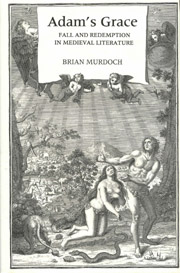Book contents
- Frontmatter
- Contents
- Ursula
- Preface
- Dedication
- Introduction: Interpreting Adam
- One After Eden: the Apocryphal Adam
- Two Written in Tablets of Stone: Adam and Gregorius
- Three Stultus et Insipiens: Adam, Parzival and the Knowledge of God
- Four Innocent Blood: Redemption and the Leper
- Five Promises to Adam: the Fall, the Redemption and Medieval Drama
- Six By the Scriptures Alone? Playing Adam in the Reformation and Beyond
- Bibliography
- Biblical Index
- General Index
Two - Written in Tablets of Stone: Adam and Gregorius
Published online by Cambridge University Press: 12 September 2012
- Frontmatter
- Contents
- Ursula
- Preface
- Dedication
- Introduction: Interpreting Adam
- One After Eden: the Apocryphal Adam
- Two Written in Tablets of Stone: Adam and Gregorius
- Three Stultus et Insipiens: Adam, Parzival and the Knowledge of God
- Four Innocent Blood: Redemption and the Leper
- Five Promises to Adam: the Fall, the Redemption and Medieval Drama
- Six By the Scriptures Alone? Playing Adam in the Reformation and Beyond
- Bibliography
- Biblical Index
- General Index
Summary
THE LIFE OF GREGORY, pope and saint, was well known throughout the Middle Ages. The French metrical Vie du Pape Saint Grégoire, which may have originated in the ambit of Henry II of England and Queen Eleanor, exists in several different versions from the late twelfth and early thirteenth centuries. An edition was a desideratum for a long time, and now that we have it, with eight rhymed versions (including two critical ones based on the London and the Tours manuscripts respectively) printed in parallel columns, with a couple of late versions added as an appendix, it is one of the most cumbersome texts imaginable. The saint's life is recorded in German in a fine poetic version by Hartmann von Aue, derived from a French source and written in about 1190, and a Middle English strophic text, also based on a French original, came just over a century later. The modern edition of the latter again prints parallel versions from several rather different manuscripts. Soon after it was composed, Hartmann's German was adapted into Latin verse by the chronicler Arnold, abbot of St John's in Lübeck, for the use of Duke Wilhelm of Lüneburg, the son of Henry the Lion and incidentally also Henry Plantagenet's grandson. Such a rendering of Gregory's life into the respectability of Latin is noteworthy of itself, and later on Hartmann's poem was put into German prose and incorporated into a much augmented compilation based on the Golden Legend (in which our saint did not, in fact, appear) called Der Heiligen Leben (Lives of the Saints).
- Type
- Chapter
- Information
- Adam's GraceFall and Redemption in Medieval Literature, pp. 50 - 75Publisher: Boydell & BrewerPrint publication year: 2000



